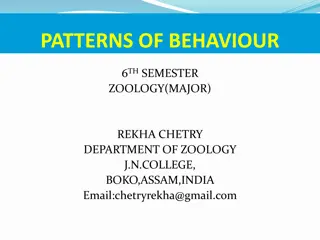Understanding Behavioural Styles: The Analyst (Technician)
Explore the concept of behavioural styles introduced by David Merrill and Roger Reid in the 1960s, focusing on the Analyst style. This style embodies traits such as organization, setting long-term goals, high standards, duty, analysis, directness, decision-making, task-oriented focus, risk-taking, and resilience. Discover how each individual possesses all four behavioural styles but defaults to one predominant style, influencing their behavior under normal conditions. Embrace the idea that there is no superior or inferior style, and that behavior is distinct from personality.
Download Presentation

Please find below an Image/Link to download the presentation.
The content on the website is provided AS IS for your information and personal use only. It may not be sold, licensed, or shared on other websites without obtaining consent from the author. Download presentation by click this link. If you encounter any issues during the download, it is possible that the publisher has removed the file from their server.
E N D
Presentation Transcript
Who Am I? Behavioural Styles SLIDE 1
Behavioural Styles 1960s - David Merrill and Roger Reid (industrial psychologists) Their BIG question: Could managerial, leadership and sales performance be predicted? They studied: How people behave in social situations. They found: People s behaviour follows two continua Assertiveness and Responsiveness. A.K.A. Push and Pull Their Behavioural Styles focus on outer behaviour, rather than the inner you. the you that s on display . Reference to Merrill & Reid (1999)
Behavioural Styles Spontaneous Expressive Amiable Dominant Easy Going Driver Analyst Self- controlled Reference to Merrill & Reid (1999)
Behavioural Styles Expressive Amiable I like I feel Let s do it together Let s do it with some fun The ability to talk about anything, anywhere, any time (with or without information); a sense of humour and optimism; a bubbly personality A balanced disposition; a pleasing personality; promoter of harmony; loyal to team and friends; genuine concern for people Analyst Driver I think I know Let s do it my way Let s do it the right way The ability to organise, to set long- term goals; the holding of high standards and ideals; a strong sense of duty; an ability to analyse Directness; the ability to quickly take charge and make decision; a focus on achieving the task; a willingness to take risks; not easily discouraged Reference to Merrill & Reid (1999)
We possess all four styles All four approaches are at our disposal. We default to one style. Our predominant style can be described by: What I find interesting What I feel is important My usual behaviour under normal conditions Behaviour is not personality All styles have evil twins There is no best or worst style
Behavioural Styles Spontaneous Expressive Amiable Dominant Easy Going Driver Analyst Self- controlled Reference to Merrill & Reid (1999)
Analyst (Tecnician) Characteristics Formal, measured and systematic Seeks accuracy and precision Dislikes unpredictability and surprise Are well organised and thorough Places high value on facts, figures, data and reason. Others describe their actions as systematic and methodical. Tend to follow an orderly approach in tackling a task May be perceived as too cautious and overly structured doing things too much by the book .
Analyst (Technician) Good at: Analysing past data Considering the present situation Projecting facts for planning purposes Being thorough Critical thinking Attention to detail
Behavioural Styles Spontaneous Expressive Amiable Dominant Easy Going Driver Analyst Self- controlled Reference to Merrill & Reid (1999)
Amiable (Relationality) Characteristics Conforming, unrushed and easy going Seeks appreciation between others Dislikes insensitivity and impatience Places high value on personal relationships, feelings, human interactions and affiliation with others. May be perceived as: warm and sensitive to the feelings of others. perceptive, able to assess a situation in terms of the human emotions a loyal and supportive friend. too emotional, sentimental and too easily swayed by others.
Amiable (Relationality) Good at: Helping others Listening Flexible working with others Learning from past events Loyalty and stickability Bringing fun and building team spirit
Behavioural Styles Spontaneous Expressive Amiable Dominant Easy Going Driver Analyst Self- controlled Reference to Merrill & Reid (1999)
Expressive (Social Creative) Characteristics Flamboyant, fast and spontaneous. Seeks recognition. Dislikes routine and boredom. Interested in taking people with them. Able to enthuse people with optimism and energy. Open and willing to make personal investment. When others don t catch the wind, can feel personally let down. May be perceived as: Scary - over-dominant and enthusiastic. Poor with detail and too willing to go with hunches
Expressive (Social Creative) Good at: Inspiring others Being persuasive Enthusiasm Working with people and at running projects Being creative and coming up with ideas
Behavioural Styles Spontaneous Expressive Amiable Dominant Easy Going Driver Analyst Self- controlled Reference to Merrill & Reid (1999)
Driver (Commander) Characteristics Business like, fast and decisive; Seeks control Dislikes inefficiency and indecision Places great emphasis on action and results. Time orientation is here and now Likes to get things done - hates spinning things out. Are dynamic and resourceful May be perceived as: Decisive, direct and pragmatic. Focused on the short term and neglecting long term implications. Impulsive and simplistic - acting before thinking
Driver (Commander) Good at: Translating ideas into action Getting things moving & overcoming resistance Being decisive Getting things done Being tough minded
Guess your style Expressive Amiable I like I feel Let s do it together Let s do it with some fun The ability to talk about anything, anywhere, any time (with or without information); a sense of humour and optimism; a bubbly personality A balanced disposition; a pleasing personality; promoter of harmony; loyal to team and friends; genuine concern for people Analyst Driver I think I know Let s do it my way Let s do it the right way The ability to organise, to set long- term goals; the holding of high standards and ideals; a strong sense of duty; an ability to analyse Directness; the ability to quickly take charge and make decision; a focus on achieving the task; a willingness to take risks; not easily discouraged Reference to Merrill & Reid (1999)
Whats your behavioural style? Match your guess with your questionnaire Which style is your predominant one?
Understanding my style Share with your colleague: This is my style and this is how it describes my behaviour This is what s good about my style . What I need to watch out for and what my blind spots are What this means for my role leading others is .
Behavioural Styles Expressive Amiable I like I feel Let s do it together Let s do it with some fun The ability to talk about anything, anywhere, any time (with or without information); a sense of humour and optimism; a bubbly personality A balanced disposition; a pleasing personality; promoter of harmony; loyal to team and friends; genuine concern for people Analyst Driver I think I know Let s do it my way Let s do it the right way The ability to organise, to set long- term goals; the holding of high standards and ideals; a strong sense of duty; an ability to analyse Directness; the ability to quickly take charge and make decision; a focus on achieving the task; a willingness to take risks; not easily discouraged Reference to Merrill & Reid (1999)
Style Buddies With your style buddies, consider the following questions How do you behave under intense pressure? What are your initial reactions to significant change that affects you? Note down the common themes to share with the rest of us
If only people were like me! SLIDE 24
Versatility Most people s social preferences are different to yours. Tension happens because of difference It is a stimulus that causes us to act rather than to remain inactive Even if we re in our comfort zones, our behaviour might be creating tension for someone else The key to successful and fruitful relationships: Understand the preferences of the people you interact with Adjust your behaviour accordingly. A high level of versatility means: Turn down your default Turn up your less used styles THE KEY TO SUCCESS IN PERSONAL RELATIONSHIPS: Not to treat others how you would like to be treated Treat others how they would like to be treated
Weaknesses and Strengths Amiable Supportive Respectful Willing Dependable Agreeable Caring for people Being task focused Excellent standards Meeting challenges Analysis Expressive Manipulative Excitable Undisciplined Reacting Egotistical ALL ARE GOOD AT Planning Meeting deadlines Being innovative Conforming Unsure Pliable Dependent Awkward Ambitious Stimulating Enthusiastic Dramatic Friendly Analyst Industrious Persistent Serious Exacting Orderly Driver Critical Indecisive Stuffy Picky Moralistic Determined Efficient Decisive Practical Strong Arrogant Hard Dominating Unsympathetic Driven Reference to Merrill & Reid (1999)
Feedback to your opposite type If you were my leader: This is what s good about your style - here are the strengths I see and appreciate This is what s not so good about your style - the weaknesses that I see and could irritate me What our style offers to you when working with you If you want to get the best from me this is how you need to lead and work with me.
Getting on with that lot! Amiable Smile, be relaxed and show interest in them as a person Be prepared to lead the discussion Give suggestions avoid statements Summarise frequently Expressive Adopt a positive attitude Return their humour Be open and direct Agree any action or agreement in specific terms Allow the ideas storm Analyst Keep to specific issues Be more formal, serious and listen Have a strong agenda and structure Don t laugh until they do Driver Don t waste time Talk work and task Get to the point Be prepared with your decision and recommendation before meeting them Reference to Merrill & Reid (1999)























